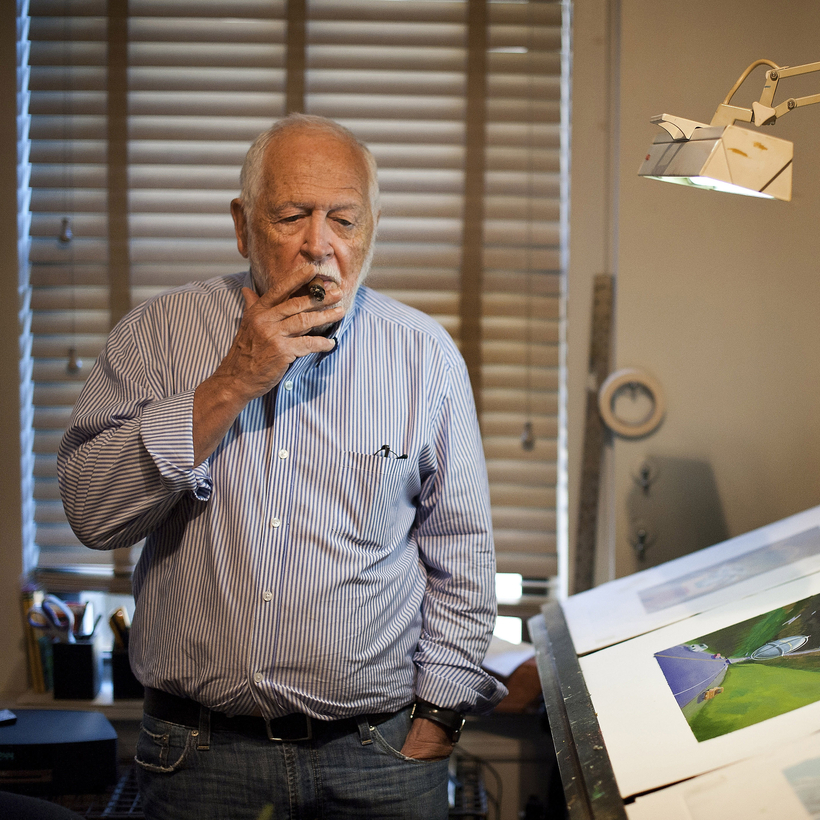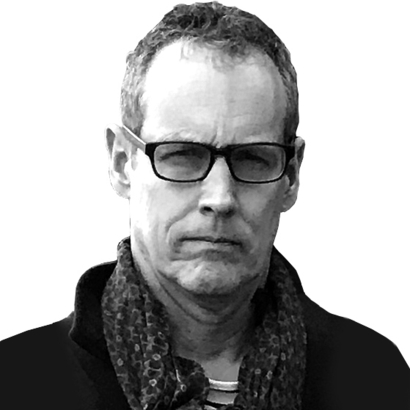You don’t want to meet your idols, the saying goes. And maybe that’s true, most times. A friend of mine once met Paul Simon and took the opportunity to say how much he valued the records Simon had made with Art Garfunkel. “That stuff was shit,” Simon replied, scowling.
Bruce McCall, artist and writer, was an idol of mine, who I not only got to meet, but work with and call a friend. Knowing him was a privilege and a joy. He died last week, at the age of 87, from Parkinson’s.
Our friendship began in 1999, when I joined Vanity Fair as an editor and Graydon Carter added Bruce to my roster of contributors. Bruce is probably best known for his work at The New Yorker, where he illustrated more than 80 covers, including a posthumous one this week, and wrote dozens of “casuals.” But I will always associate him with National Lampoon, where I first encountered his work, in the early 1970s.
That magazine’s regulars included many singularly brilliant writers and artists, but even among that sharp, elbowing crowd, Bruce stood out. While most Lampoon humor was vehemently of its moment, Bruce’s work felt timeless from the get-go. He was Duke Ellington sharing the stage at Woodstock.

The Lampoon’s ethos was in your face, the tenor of its wit gleefully vicious when not deliberately offensive; the counterculture’s sacred cows got it just as bad as Nixon and Agnew. Bruce’s pieces, by contrast, were refined, impeccable, charmingly retro; he was at play in the worlds of Art Deco, Streamline Moderne, and Atomic This or That.
The humor was nostalgic but also anti-nostalgic: beneath the preoccupations with arcane transportation, outdated visions of the future, pneumatic tubes, and miracle fabrics, he was critiquing midcentury American arrogance and moneyed, old-world obliviousness, those twin pillars of overkill and waste. Bruce was probably as pissed off as any 1970s satirist—he just sublimated better.
His visuals, typically executed with painstaking detail in gouache on paper or board, were dreamlike in that he took familiar objects, places, and spaces and twisted them askew, playing with scale, perspective, and elementary physics but rendering the results with a deadpan realism that made the fantastic look matter-of-fact. You could call him a funnier Magritte.
Bruce McCall’s work felt timeless from the get-go. He was Duke Ellington sharing the stage at Woodstock.
A few favorite images: first-class airline passengers dining on tables with white linen service set on airplane wings (which became the cover of his first collection, Bruce McCall’s Zany Afternoons); a hunting party blasting zeppelins from the sky as if they were grouse; “the Sphinx of La Cienega,” an abandoned movie set towering over 1920s Los Angeles like Mount Everest. Bruce’s brochure for the R.M.S. Tyrannic (“Sail On, O Mighty Mammoth!”) featured a vertigo-inducing grand staircase and a promenade deck seemingly as vast as the Sahara. His ’58 Bulgemobile had fins upon fins, miles of chrome, and bench seats wide enough to hold the entire Kennedy family.

To my mind, Bruce was the world’s first satiric architect, product designer, urban planner, and automotive engineer (and surely could have gone straight and succeeded in any of those fields had he wanted to). Few comic artists ever had a better sense of how to use perspective and composition to tell a joke, the visual equivalent of perfect timing; Bruce was up there with Norman Rockwell and Peter Arno.
A terrific example is his illustration Hoplock’s Amazing Catch in the 1946 World Series, which first ran in the November 1973 National Lampoon as part of the feature “Doc Feeney’s Scrapbook of Sports Oddities.” In the black-and-white illustration, Hoplock, an outfielder, soars above the bleachers, 40 or so feet in the air, isolated against shadows, his arm reaching for a small white baseball, Bruce positioning ballplayer and orb just so, testing the elasticity of both gravity and joke, hitting on the perfect note of implausibility. Had Bruce raised or lowered Hoplock even a smidgen, I guarantee you it wouldn’t have been as funny.
You could call him a funnier Magritte.
The first piece Bruce did for me at Vanity Fair was “The Lost Sketchbooks of Albert Speer,” which posited that Hitler’s favorite architect, following his release from Spandau Prison, had ended up plying his trade in postwar America, where he designed monumental bowling alleys, car washes, and tourist traps. It was perhaps the ultimate Bruce McCall concept: a fusion of Third Reich bombast with American roadside vernacular—bullshit two ways.

I remember our first meeting, over lunch, probably at Café Luxembourg on the Upper West Side, Bruce’s de facto club. I was intimidated—Bruce had a sometimes gruff, even cranky exterior—and to his taste I was probably overdoing the opening compliments. Not that Bruce didn’t like praise; he wasn’t falsely modest, but he was his own harshest critic and he certainly didn’t care for florid praise. He was Canadian, after all.
Anyway, one of the first things he told me was “I like being edited.” I can’t remember if he added “Relax,” but that was his point. It was my introduction to Bruce’s directness, and to his generosity.
He did like being edited. In fact, he was hungry for input in general. You’d sit down with him and right off he’d want to know, What have you read? What have you heard? What’s going on? What’s interesting? He himself had seemingly read every new book that was worth reading, and seemingly knew everyone worth knowing. At a dinner party at his apartment on Central Park West, you might meet Ricky Jay or Kim Cattrall. At lunch, Ron Chernow might stop by the table to say hello. Steve Martin was a pal; David Letterman, a collaborator.

When I say he was cranky, I mean it in the best way: he was cranky about things worth being irritated by, things that too many of us might shrug at or endure in sullen silence—idiocy, mediocrity, mendacity, cant. If you knew anything about Bruce’s past, you got where he was coming from, figuratively as well as literally, and you shared in his amazement at where he had landed.
He was born in 1935 in Simcoe, Ontario, a small town of 6,000 steeped in the dour Scotch-Canadian tradition and hardly a place to nurture artistic genius. As he wrote in the second of two memoirs, How Did I Get Here?: “Scottish Conservatism is as close to the opposite of Florentine culture as can be imagined. Piano lessons and church choirs sufficed as culture, which otherwise had no role in the life of the town.... We were unwitting cultural morons who couldn’t miss what we never had.”
At a dinner party at his apartment on Central Park West, you might meet Ricky Jay or Kim Cattrall. Steve Martin was a pal; David Letterman, a collaborator.
Home, where Bruce was one of six children, was even grimmer: “In spirit, we were barely a family.” Of his father, a frequently absent civil servant with a thin salary, Bruce observed: “He was no hypocrite. He never pretended to be a doting dad. I hadn’t expected much and wasn’t disappointed.” His mother, burdened by housework, bills, and loneliness, “was a living billboard for nice folks making themselves dizzy drunk and soon enough full-fledged alcoholics.”
On himself as a boy: “Melancholia shouldn’t afflict innocent kids, so I must have been precocious.”
He was certainly precocious as a writer and a largely self-taught artist, inspired in part by two weekly rays of American sunshine amid the Canadian-McCallian bleakness. One was The Saturday Evening Post, with its roster of master illustrators from whose examples, Rockwell’s in particular, Bruce began learning the ropes. The other was The New Yorker, to which both his parents were perhaps improbably devoted and which for Bruce became a “childhood fixation,” a beacon from a distant fantasyland full of wit, intelligence, sophistication, and ads for Adirondack chairs. “It figured in my dreams before I even knew what made this then-drowsy magazine so special.”
“Melancholia shouldn’t afflict innocent kids, so I must have been precocious.”
That Bruce would become one of The New Yorker’s mainstays is a gloriously happy ending, almost Dickensian; if it wasn’t true, you’d call it corny. It took some doing. First he dropped out of high school and tried to make it as an automotive journalist in Toronto. He eventually found his way into advertising, first in Detroit (where, he once told me, he learned to drink Rob Roys at lunch in order to fit in), then in Manhattan—the big leagues—where he was put on the Ford account at J. Walter Thompson and later, at Ogilvy & Mather, Mercedes-Benz. He published his first illustrated humor piece in Playboy, in 1971. Two decades later he finally ditched advertising for good, dedicating his talents to art and satire full-time.
He was one of the great voluntary New Yorkers, emblematic of E. B. White’s famous line about not bothering to show up unless you’re “willing to be lucky” (and to work hard). Bruce was clearly lucky in his family of choice. I didn’t know him intimately enough to see his tender side too often, but it was there, and it rose instantly to the surface whenever he talked about his wife, Polly, a psychotherapist, and their daughter, Amanda, a writer with her own gift for satire, who Bruce was immensely proud of. As a parent, he was not his father’s son.

It was a thrill for me, at Vanity Fair, to be the first person outside his home studio to set eyes on a new McCall. The less obvious pleasure was in handling the physical paintings. You would often see little dabs on the margins, where Bruce was, I’m guessing, trying out colors or adjusting his brushes.
And always, the work reeked of the cigars he smoked as he painted, almost a second signature. The sweet aroma would make me laugh, but it also reminded me of the hours and care, the craft and intelligence—the labor—that went into making those illustrations so meticulous, those compositions so perfect, that wit so honed.
We’ll always have the art. I miss the artist.
Bruce McCall, artist and writer, was born on May 10, 1935, in Simcoe, Ontario, Canada. He died on May 5, aged 87
Bruce Handy is a journalist and the author of Wild Things: The Joy of Reading Children’s Literature as an Adult

